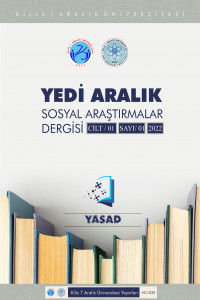Ravvâs'ın Şiirinde Hayvan Adlarının Anlamsal Kullanımı
Sahabe ve Tabiin döneminden sonra birçok kavim ve millet İslam dinine girmiş, ilim dairesi genişleyerek ihtisas erbapları arasında taksim olup dağıtılmıştı. Her güruh diğerinden daha üstün olduğu sanat ve ilim alanında eserler ortaya koymuş böylece nahiv ilminden sonra başlıca fıkıh, tevhid hadis Usulu’d-Dîn, tefsîr, mantık, hadîs ıstılahı, usûl ilmi, ferâiz ve mirâs gibi ilimler ortaya çıkmıştır. Ancak bu dönemden sonra manevi etki yavaş yavaş zayıflamaya başlamış, insanlar Allah’a kulluk bilinciyle yönelmenin gerekliliğini unutmaya başlamıştı. Bu da Tasavvuf âlimleri tasavvuf ilminin yüceliğini, faziletini ve diğer ilimlere olan üstünlüğünü, kusurları giderme hayatın tüm alanlarında dini ihtiyaçları kemale erdirme gayesiyle ispat edip bu ilmin tedvin edilmesine gayret gösterilmesi hususunda çalışmaya davet etmişlerdir. Tasavvuf İslam ve iman esaslarından sonra üçüncü bir esas sayılan nefis ve kalbin kötülüklerden arındırılıp faziletlerle doldurulması esasını, ihsan ve terbiye makamlarını hakikate dönüştürmeyi hedeflemektedir. Tasavvufçular genellikle sözlerinde açıklıktan kaçınıp ima etmeyi tercih ederler. Çünkü açık lafızların ulaşmak istedikleri amaçlara kendilerini ulaştıramayacağını bilirler. er-Revvas kalplerinde doğan manaları dile getirirken işaret, sembol gibi ifadelere başvuran tasavvufçulardan biridir. O yaşadığı vicdani durumu ifade ederken kullandığı hayvan isimlerinde sembollerden yararlanmıştır. Her bir isim onun dile getirmek istediği özlem, hüzün, ayrılık acısı, cesaret vb. anlamlara işaret etmektedir. er-Revvas’a göre tasavvuf ehlinin kendine özgü durumunu ve makamını geliştiren bir dili vardır onunla şiir dairesine girerek şairin istediği işaretler, yargılar, anlamlar ve semboller ile metnin derin yapısına ulaşır. Bu semboller şairdeki ruhsal ve duygusal deneyiminden doğan birçok yorumu ortaya çıkarır. Bu da sadece tasavvuf deneyimini yaşayan, tadan ve bilen kişilerin anlayabildiği kendine has özgün ve terimleri olan bir dildir. Bu dil anlam yönünün açık, ihtimal ve varlık sınırlılıklarına uygun çizilebilen, okuyucunun net olarak gizemine ve derinliğine ulaşamayıp anlamlandıramadığı onu bir tür karmaşıklığa sokan bir dildir. Sözlükler sûfînin yaşadığı ruhsal durum karşısında yetersiz kalmaktadır.
The Semantic Study of Animal Names in Rawas’ Poetry
After the period of the Companions and the Tabi'un, many tribes and nations converted to Islam, the circle of science was expanded and divided among the specialists. Each group has produced works in the field of art and science, in which it is superior to the other, so that , the science of jurisprudence, the science of monotheism, the sciences of hadith, the principles of religion, interpretation, logic, the term hadith, the science of assets, inheritance obligations and others have emerged. However, after this period, the spiritual influence began to weaken gradually. People began to forget the necessity of turning to God with the consciousness of servitude. This situation encouraged Sufi scholars to prove the greatness and virtue of the science of Sufism and its superiority over other sciences, to make up for the inadequacies and to strive for the compilation of this science in order to perfect the religious needs in all areas of life. Sufism aims to transform the principles of goodness and education into truth, the principle of purifying them from vices and adorning them with virtues, which is the third pillar of the complete Islamic religion after the two pillars of Islam and faith. The Sufi has a special language in which his conditions and positions grow, through which he was able to expand the boundaries of his poetic circle and access the deep structure of the text. Because they know that clear words cannot reach the goals they want to achieve. Er-Revvas is one of the Sufis who make use of expressions such as signs, allusions and symbols while expressing the meanings they carry in their hearts. He used symbols in animal names while expressing her conscientiousness. Each name expresses the longing, sadness, pain of separation, courage, etc. that he wants to express. According to Er-Revvas, the people of mysticism have a language that develops their unique status and rank, and by entering the poetry circle with it, they reach the deep structure of the text with the signs, judgments, meanings and symbols desired by the poet. These symbols reveal many interpretations of the poet's spiritual and emotional experience. This is a language that is unique and has terms that only people who have experienced and know Sufism can understand. The meaning of this language, which can be drawn clearly, in accordance with the possibilities and limitations of existence, where the reader cannot clearly reach its mystery and depth and make sense of it, puts the reader into a kind of complexity. Dictionaries are also insufficient in the presence of this spiritual condition of the Sufi.
Keywords:
Rawas. the symbol, antelope, hazar, blackbird, the lion,
___
- Abdulcelîl, M. B. (1986). el-Mecâz ve Eseruhu Fi'd-Dirsâti'l-Lugavî. Dâru'n-Nahda.
- Ahmed, M. F.(1978). er-Remziyye ve'r-Remz, Daru'l-Ma'arif.
- el-Hams, S. H. (2007). Şi‘ru Bişr b. Ebi Hâzem, Dirâsetun Uslûbiyye, [Yüksek Lisan Tezi, Gazze Ezher Üniversitesi]
- el-Kaysî, N. M.(1970). et-Tabi'a fiş-Şiir'l-Cahilî. Daru'l-İrşâd.
- Nasr, A. C. (1978). er-Ramz eş-Ş'iri 'İnde's-Sûfiyye. Dâru'l-Endelus Daru'l-Kindî.
- er-Ravvâs, M. M. R. (1968). Divân Nuru'l-Fûtûh Thk: Abdulhakîm b. Selîm Abdulbasît
- er-Ravvâs, M. M. R. (1969). Divân Mi'râcu'l-Kulûb Thk: Abdulhakîm b. Selîm Abdulbasît
- r-Ravvâs, , M. M. R. (1968). Bevâriku'l-Hakâik .Thk: Abdulhakîm b. Selîm Abdulbasît
- Yâsûf, A. Z. (2020). Dirâsât fi el-Hadîs en-Nebevî. Dâru’l-Furkân lil’luğât ve’l-Âdâb.
- Başlangıç: 2022
- Yayıncı: Kilis 7 Aralık Üniversitesi
Sayıdaki Diğer Makaleler
İlkokul 4. Sınıf Öğrencilerinin Anne Baba Tutumlarının Farklı Değişkenlere Göre İncelenmesi
Ravvâs'ın Şiirinde Hayvan Adlarının Anlamsal Kullanımı
Modern Cezayir Romanına Bir Bakış
Pandemi Sürecinde Eğitimde Eşitsizliğin Yeniden Üretiminde Annenin Katkısı
Yeter KARABOĞA, Mehmet Fatih GÜLOĞLU
Değer Varlığı Olarak İnsan ve Eğitim
Davkale’nin el-Kasidetu’l-Yetîme Adlı Trajik Aşk Şiirindeki Semantik Alanlar
